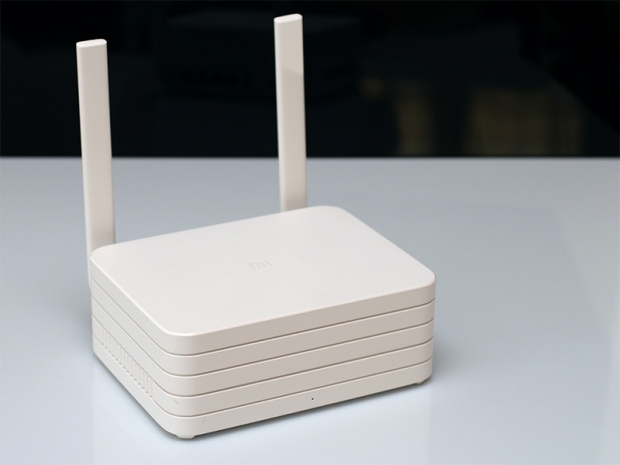Index
Review: Taking the Xiaomi route
Xiaomi is no stranger to the networking market, and the Chinese tech giant already made it clear that phones, tablets and routers are its core products. Accessories and laptop bags are not.
Home Wi-Fi routers or access points are commonplace in our homes these days, but very few people actually care about them. Most are content with what they get from their cable operator or telco, but this is slowly starting to change.
In the past, when we were all using 802.11b/g/n 2.4GHz devices, most people picked an out-of-sight place for their home router, and we all got used to having good signal coverage on the 2.4GHz band. Most single floor apartments or homes enjoyed good coverage and people could go online without worrying about Wi-Fi repeaters or similar devices.

However, with the introduction of the IEEE 802.11ac 5GHz standard and new high-bandwidth devices over the past couple of years, things starting change for better, or worse. The 802.11ac standard promises far greater network speeds over the 5GHz band with one major advantage and one major drawback: the 5GHz radio band is not as crowded as the old 2.4GHz, but on the other hand, the higher frequency 5GHz signal has more trouble penetrating obstacles – namely walls in our homes and offices. So, if you want to benefit from your new 802.11ac equipment and make good use of high network speeds the new standard offers, the closer you are to the router, the better.

Now, 802.11ac routers are coming (back) to our living rooms and back into view, hence most of these devices have the looks for it. They have to look and perform well, which is easier said than done, especially when dealing with devices that tend to have antennas and cables sticking out of them.
We sourced a Xiaomi Mi WiFi Router 2 1TB review sample and decided to test it out in a home/home office. The router was supposed to cover two homes and an office, in a three-story building. The sample was provided by Gearbest, which sells the router for $169 with free shipping.
Design and Build Quality
At first, we were surprised with the weight of the device – 1264 grams, the weight of an ultraportable notebook, or two 10-inch tablets! This thing feels heavy and it is built like a tank. Of course, it has to be on the heavy side, as it has a 3.5-inch 1TB hard drive under the bonnet, backed by an active cooling system.

We were expecting a substantial device, but still, we were surprised. The finish looks and feels premium, like something you'd find on a smartphone or mini PC.

The front side features a single RGB LED that shows the status of the device according to its color: red, yellow or blue.
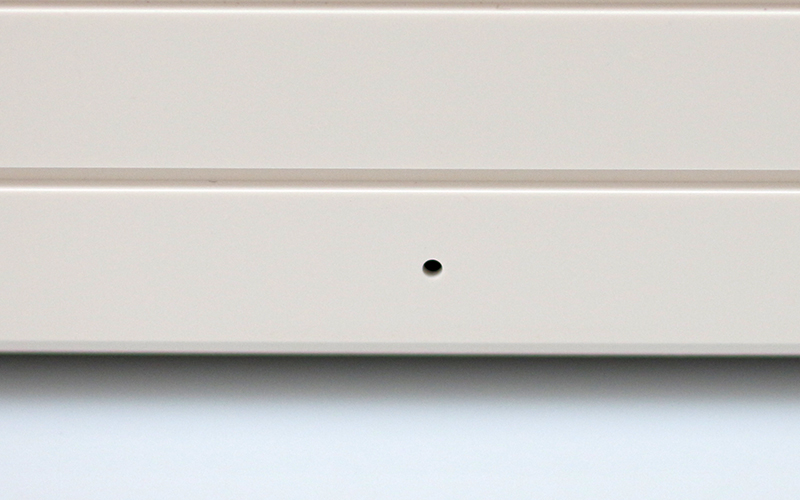
All the connectors are located at the back and everything is laid out logically. The router relies on 12V DC power, and the DC port is flanked by the power and reset buttons.

Moving right, you’ll find a USB port, three LAN ports and the WAN port.
We have only one complaint about the layout – we are accustomed to the WAN port being colored differently than the LAN ports, Xiaomi could have highlighted the WAN port in a different color.
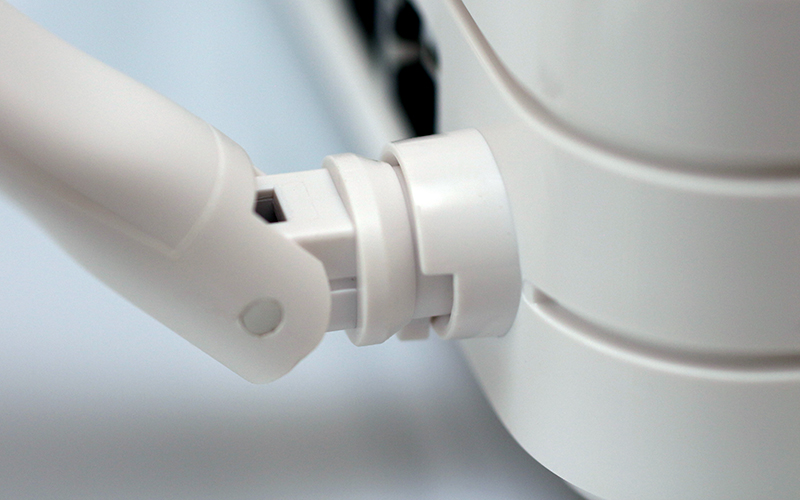
The antennas are located on the sides, as you would expect.

The internals are also well thought through, as this device sports various internal interference shields and an active air cooling system that wouldn’t look out of place on a graphics card.

It's basically a blower-fan design, scooping up fresh air on the right and pushing it out through the exaust vents on the left.

The cooler stays inaudible at all times, which is good if you plan to place the router in your living room or office.
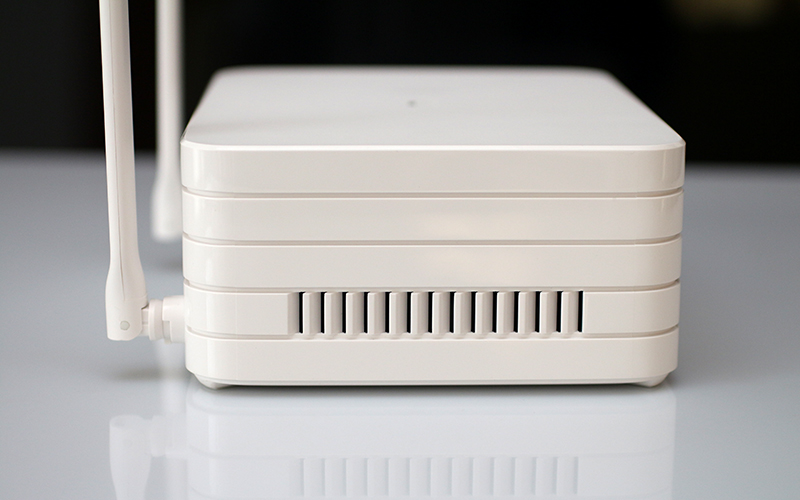
Another welcome feature is the use of two external PCB antennas, which help improve the range and signal coverage. Also, this router features smart signal tracking technology – beamforming – as implemented in the 802.11ac standard.

Setup and Installation
The retail box contains the router, a small user guide in Chinese and a 12V 3A power supply.

The setup is pretty simple and straightforward, and the plastic wrapping of the router lists three easy steps for installation as well as a QR code to download the Xiaomi router app for Android, iOS and Windows.
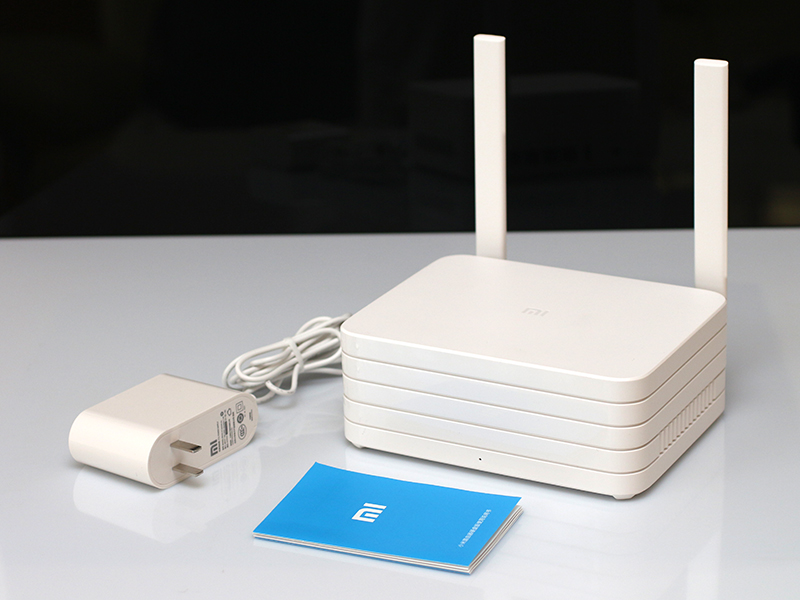
We connected the power and WAN cables, powered up the router, downloaded and started the Xiaomi app (which is in English, well, mostly). The app automatically connected to the router's wireless network, then guided us to sign in or create a Xiaomi Mi account, and in the end we were asked to change the SSID and password of our new wireless networks and we were good to go. If you are swapping out your old router, it’s obviously a good idea to download and install the router app first, while you still have internet connectivity through the old router.
Like all 802.11ac routers, this the Xiaomi Router 2 creates two Wi-Fi networks: one at 2.4GHz for 802.11b/g/n devices, and another at 5GHz for your new 802.11ac kit. We were puzzled as to why none of our devices could see the 5GHz network we created, and we logged into the router's web based UI, only to be greeted with Chinese UI. Using Google Chrome and Google Translate plugin did the trick and we had the web UI in English.
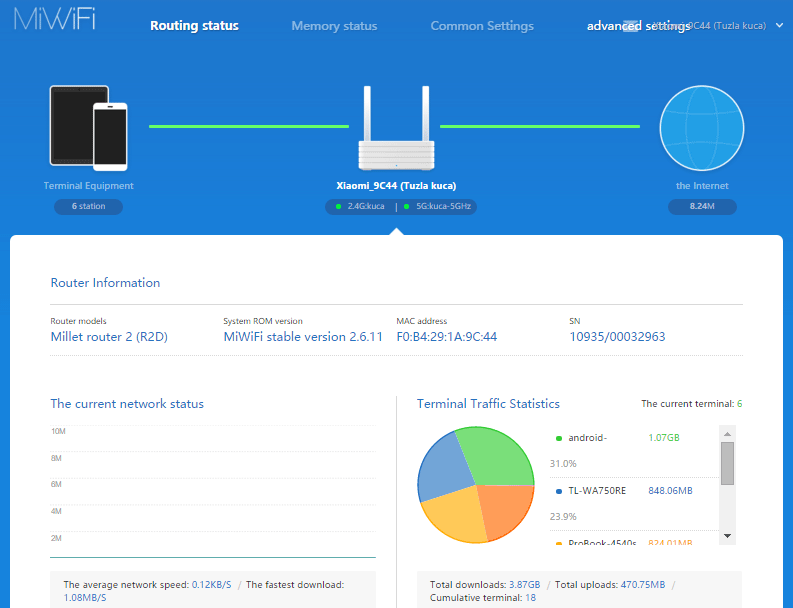
We found our 5GHz network running on channel 149 which is OK for China, North America and Russia, but almost all devices made for the EU market only support 802.11ac on channels 36, 40, 44 and 48. Use of channels from 50 to 140 is allowed in the EU but manufacturers have to implement DFC/TPC protocols on these channels, so most vendors simply choose to disable this channel range in their EU products. And if all this wasn't complicated enough, DFC detects presence of radar signals and changes the communication channel to minimize interference with the radar signal.
Changing the 5GHz channel to 44 did the trick and our EU 802.11ac devices came to life and worked like a charm.
SMB Windows file sharing worked out of the box, and anything we copied to the router's hard drive was also visible on our TV through DLNA instantly, without any changes to the default settings.
Specifications, Performance, Signal Coverage
First, let’s cover the Xiaomi Mi WiFi Router 2 1TB specifications:
- Wireless standards: Wi-Fi 802.11a/b/g/n/ac, 802.3/3u/3ab
- Maximum transfer speed: 2,4GHz max 300Mbps / 5GHz max 867 Mbps
- Interfaces: single USB 2.0 port (5V 1A power output), 1x gigabit WAN port, 3x gigabit LAN ports
- Wireless security: WPA-PSK / WPA2-PSK Encryption, wireless access control (blacklist), hidden SSID
- CPU: BCM4709C Cortex-A9 Dual-core 1.4GHz
- RAM: 256MB DDR3-1600
- ROM: 512MB SLC NAND Flash
- HDD: 1TB 3.5-inch
- Supported USB modes: external drive / printer / 3G-modem
- Supported platforms: Web, iOS, Android, Windows
- Dimensions: 18.4 cm x 16.9 cm x 13.1 cm
- Weight: 1264g
You can check out the full Xiaomi Mi WiFi Router 2 spec on the official product site.
We decided to compare the performance and signal coverage between the Xiaomi router and the D-Link AC750 (2,4GHz @ 300Mbps/5GHz @ 433 Mbps) router that was already installed at the test location.
Router bandwidth was tested using a desktop PC with an Asus PCE-AC68 AC1900 Wi-Fi adapter as a client and another PC connected to the gigabit LAN port on the router.

Of course, being an AC1200 spec router, we expected the Xiaomi to double D-Link's performance on the 5GHz band, but Xiaomi was even better. We got similar results on the 2.4GHz front, proving that the Xiaomi router is a very potent piece of kit.
The Wi-Fi signal strength was measured at two specific locations and results are compared on the following graphs:
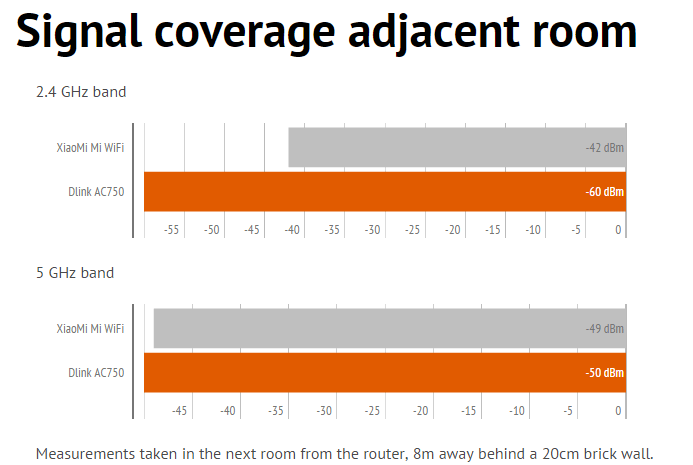

Surprisingly, we got better signal coverage with the tested Xiaomi router in every scenario we tried against the D-Link router, at both 2.4 and 5 GHz bands. Even one floor below or above the router signal levels were acceptable on the 2.4GHz band.
Also as an illustration, we measured the bandwidth again at our second signal strength test location and we got 101Mbps on the 2.4GHz band and 198Mbps on the 5GHz band. This just shows that the 5GHz band suffered a 40% decrease in bandwidth at this location, and the 2.4GHz band performance was virtually unaffected at 11 meters and two 20cm brick walls away from the router.
Overall, the new Xiaomi router exceeded our expectations in both bandwidth and signal coverage.
User interface and everyday use
We noticed that the Xiaomi router app running on Android did not feature settings for the wireless channel, but it had some other settings that we did not find in the router's web UI. Router plugins and HDD management are only accessible from the Android app, there is no trace of these options in the web-based UI. These inconsistencies, along with the lack of proper multilingual support, are the biggest downside to the router.
The Xiaomi router offers all the advanced options commonly found on modern routers: you can create a visitors WLAN network, QoS management by client MAC address, you can assign default IP addresses for clients over their MAC address or block clients from connecting to your network.
There is also a time schedule option that can turn your WLAN networks on or off or schedule the router to power on or off, reboot and check for firmware updates, an automatic backup from USB to router HDD for cameras and other USB storage devices.
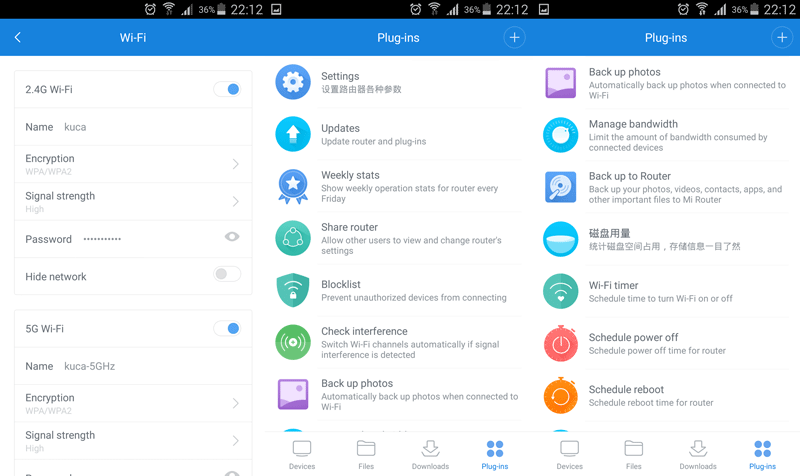
You can also install additional applications and plugins, like download managers, signal quality optimization tools (that messed up our 5GHz channel again), backup tools for smartphones etc. The Xiaomi router app also enables you to control your router and access files saved on its hard drive from anywhere, locally or remotely.
We also tried the Windows router app and we were disappointed to see that it was only available in Chinese, but it also offers different automated tasks like backup to router HDD.
NAS storage and DLNA worked like a charm every time, our TV made good use of the bandwidth of the 5GHz band for DLNA streams from the router's HDD. In theory, this router can do even more, but some of the plugins are in Chinese, so you would have to go through the trouble of translating and trying them out to see what they can do.
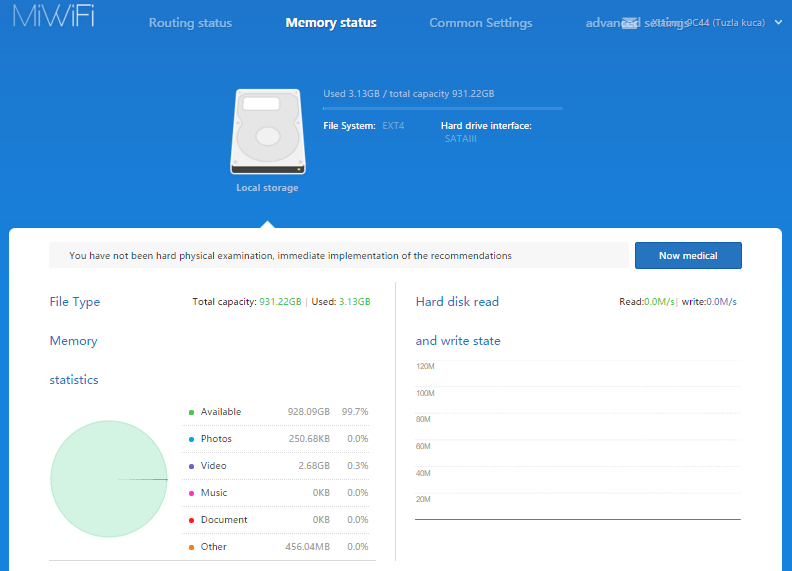
Google Translate in web app - could be worse.
As usual, this is the biggest issue when it comes to Xiaomi networking gear – these products are designed for mainland China, so international users miss out on some features and services. However, we are happy to report that other Xiaomi gear we had laying around the office worked perfectly; a couple of phones and a Xiaomi TV box recognized the router instantly, and the TV box obviously stands to gain a lot from the added 1TB of storage.
Conclusion
The Xiaomi Mi WiFi Router 2 is a powerful 802.11ac box with a lot of nifty features. The device is available with 1TB or 6TB of storage, although the latter is rather pricey at $622.
We suspect most home users will go for the 1TB version. Of course, you could use the USB port to add a secondary drive should you need more storage. Needless to say, we would have been happier with a USB 3.0 port, but Xiaomi opted for USB 2.0 instead. Too bad Xiaomi doesn’t offer more storage options – we feel a 2TB, 3TB or 4TB version in between the currently available models would make perfect sense.

As a router, the device works quite well: The processor if fast enough to keep up with a lot of devices and operations simultaneously, signal strength and bandwidth are good as well. The 1TB drive obviously adds a fair amount of value to the product and makes it more flexible. A decent 1TB NAS drive would set you back about $100, so $169 for a speedy all-in-one router sounds like a good deal.
Like we said, the biggest downside is limited multilingual support. Xiaomi simply isn’t focused on international markets (at least not yet), so the mobile apps and web interface aren’t as good as they should be. For some people, this could be a deal breaker. However, if you don’t plan on playing around with the settings all the time, and if you just want a speedy router with integrated storage, the Xiaomi Mi WiFi Router 2 is a good choice.
Xiaomi Mi WiFi Router 2 1TB Pros and Cons
Pros
- Performance
- Build quality
- Value for money
Cons
- Inadequate multilingual support
- No USB 3.0 port
- No 2TB or 4TB option

